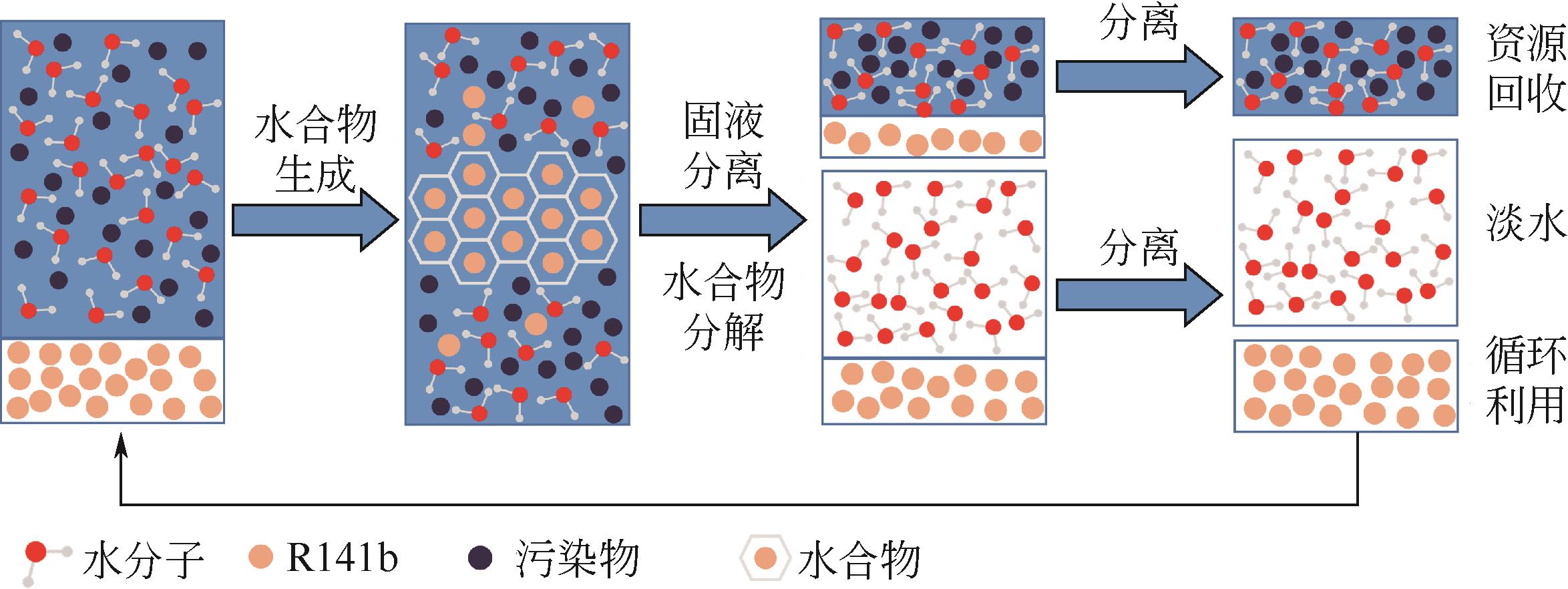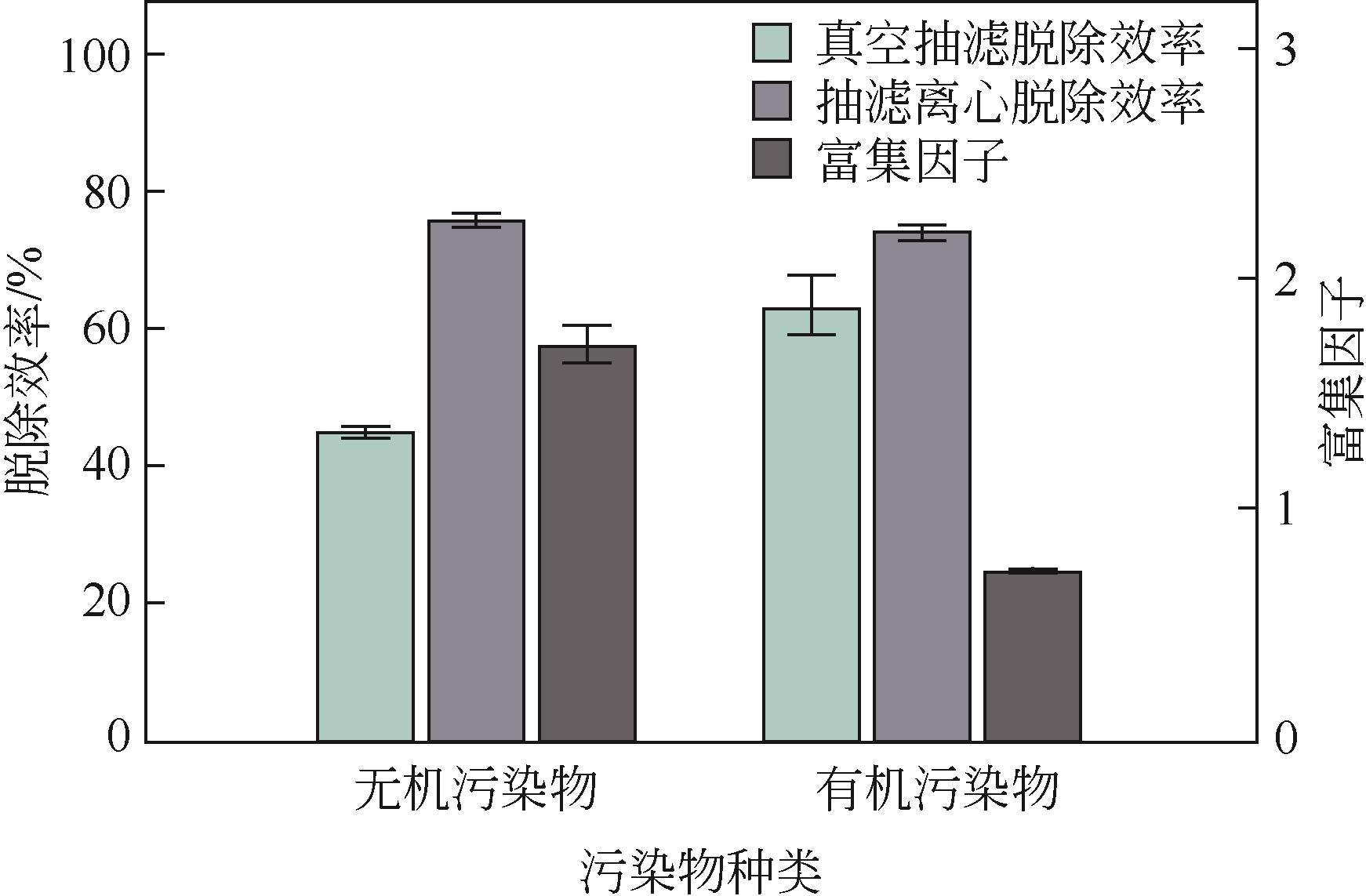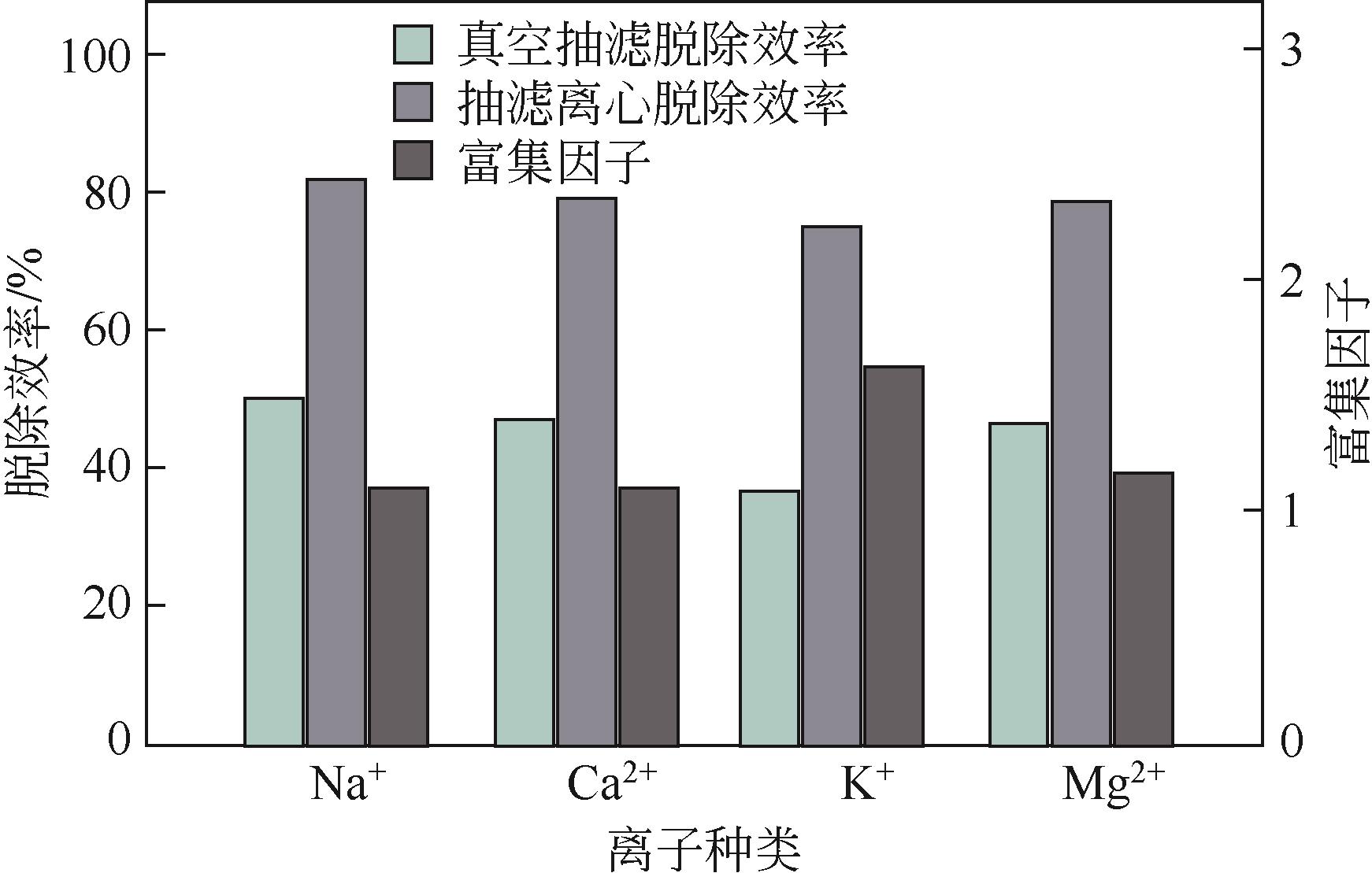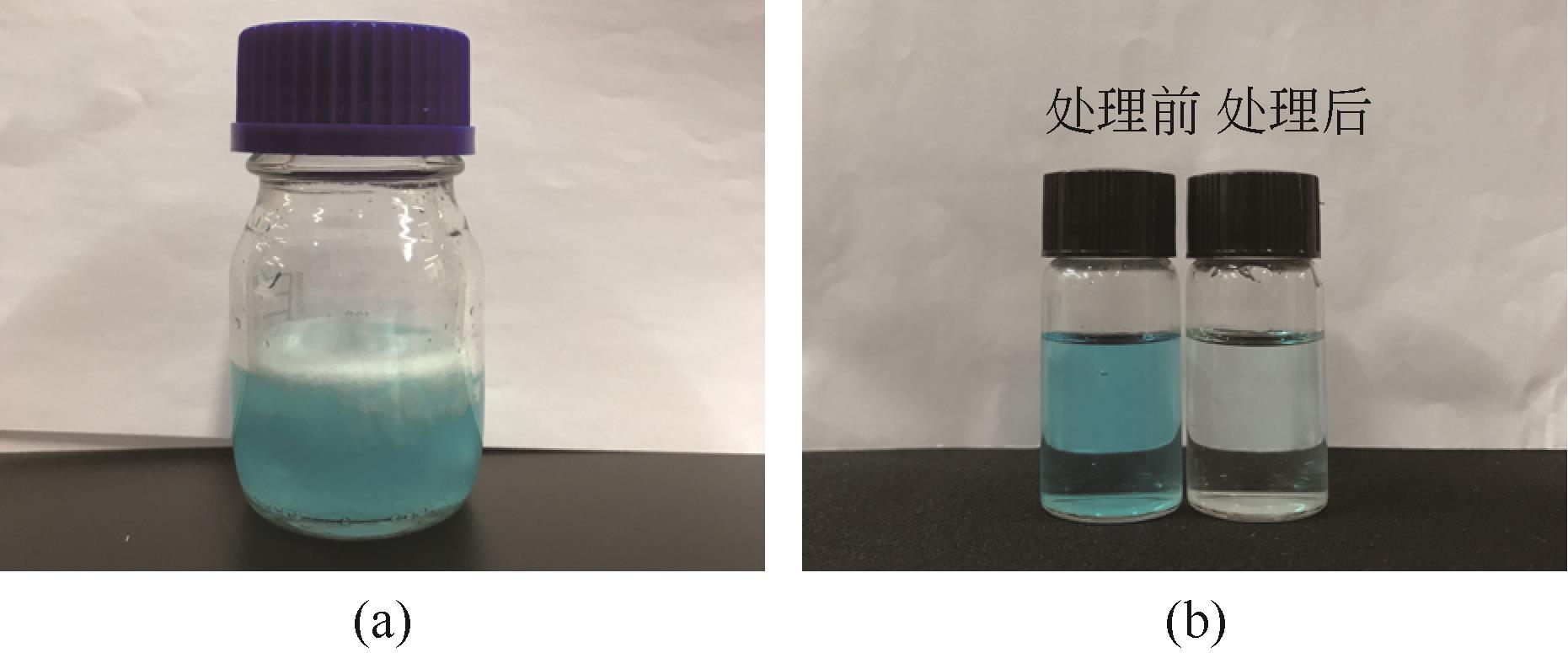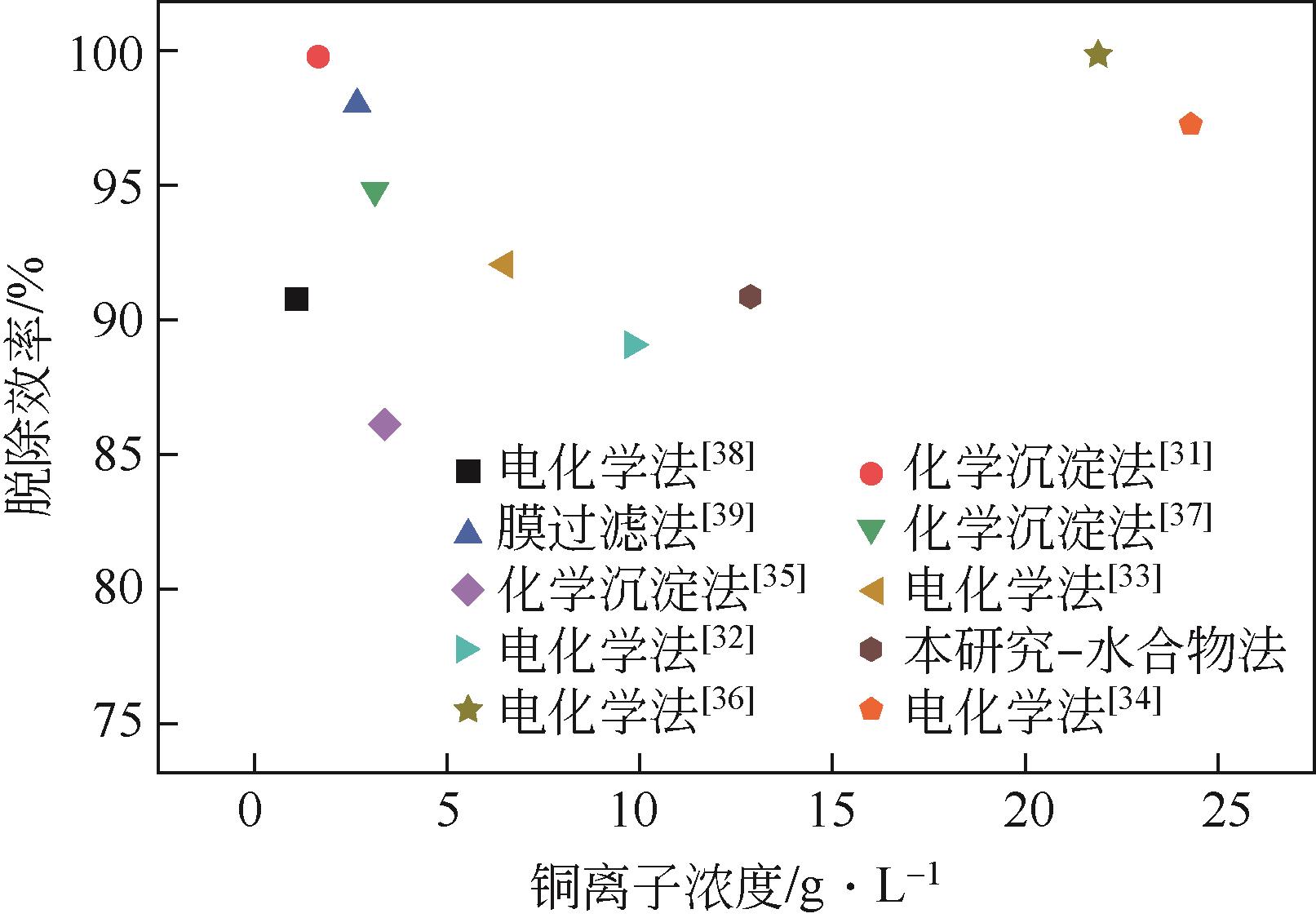Chemical Industry and Engineering Progress ›› 2022, Vol. 41 ›› Issue (12): 6672-6679.DOI: 10.16085/j.issn.1000-6613.2022-0319
• Resources and environmental engineering • Previous Articles Next Articles
Research on the application of hydrate-based method in the treatment of actual complex wastewater and high salt wastewater
SUN Huilian( ), SUN Lingjie, ZHAO Yang, SUN Xiang(
), SUN Lingjie, ZHAO Yang, SUN Xiang( ), ZHANG Lunxiang(
), ZHANG Lunxiang( )
)
- Key Laboratory of Ocean Energy Utilization and Energy Conservation of the Ministry of Education, Dalian University of Technology, Dalian 116024, Liaoning, China
-
Received:2022-03-03Revised:2022-04-25Online:2022-12-29Published:2022-12-20 -
Contact:SUN Xiang, ZHANG Lunxiang
水合物法处理实际复杂废水及高盐废水
- 大连理工大学海洋能源利用与节能教育部重点实验室,辽宁 大连 116024
-
通讯作者:孙翔,张伦祥 -
作者简介:孙汇莲(1999—),女,硕士研究生,研究方向为水合物技术应用。E-mail:huiliansun@163.com。 -
基金资助:国家自然科学基金(52020105007)
CLC Number:
Cite this article
SUN Huilian, SUN Lingjie, ZHAO Yang, SUN Xiang, ZHANG Lunxiang. Research on the application of hydrate-based method in the treatment of actual complex wastewater and high salt wastewater[J]. Chemical Industry and Engineering Progress, 2022, 41(12): 6672-6679.
孙汇莲, 孙灵杰, 赵杨, 孙翔, 张伦祥. 水合物法处理实际复杂废水及高盐废水[J]. 化工进展, 2022, 41(12): 6672-6679.
share this article
Add to citation manager EndNote|Ris|BibTeX
URL: https://hgjz.cip.com.cn/EN/10.16085/j.issn.1000-6613.2022-0319
| 无机物种类 | 浓度/mg∙L-1 | 无机物种类 | 浓度/mg∙L-1 |
|---|---|---|---|
| Na | 2248.04 | Cu | 0.10 |
| Ca | 393.11 | Mn | 0.06 |
| K | 190.71 | Hg | 0.04 |
| Mg | 99.49 | Se | 0.03 |
| Zn | 0.27 |
| 无机物种类 | 浓度/mg∙L-1 | 无机物种类 | 浓度/mg∙L-1 |
|---|---|---|---|
| Na | 2248.04 | Cu | 0.10 |
| Ca | 393.11 | Mn | 0.06 |
| K | 190.71 | Hg | 0.04 |
| Mg | 99.49 | Se | 0.03 |
| Zn | 0.27 |
| 序号 | 电导率/mS∙cm-1 | 分解质量 /g | 抽滤效率 /% | 离心效率 /% | 产水率 /% | 富集 因子 | 平均抽滤效率 /% | 平均离心效率 /% | 平均产水率 /% | 平均富集因子 | |||
|---|---|---|---|---|---|---|---|---|---|---|---|---|---|
| 原废水样 | 分解水Ed1 | 分解水Ed2 | 浓缩废水 | ||||||||||
| 1 | 11.43 | 6.32 | 2.59 | 19.98 | 30.88 | 44.71 | 77.34 | 77.19 | 1.748 | 44.97 | 76.00 | 78.87 | 1.724 |
| 2 | 11.43 | 6.37 | 2.75 | 20.74 | 30.77 | 44.27 | 75.94 | 76.93 | 1.815 | ||||
| 3 | 11.43 | 6.18 | 2.89 | 18.40 | 33.00 | 45.93 | 74.72 | 82.49 | 1.610 | ||||
| 序号 | 电导率/mS∙cm-1 | 分解质量 /g | 抽滤效率 /% | 离心效率 /% | 产水率 /% | 富集 因子 | 平均抽滤效率 /% | 平均离心效率 /% | 平均产水率 /% | 平均富集因子 | |||
|---|---|---|---|---|---|---|---|---|---|---|---|---|---|
| 原废水样 | 分解水Ed1 | 分解水Ed2 | 浓缩废水 | ||||||||||
| 1 | 11.43 | 6.32 | 2.59 | 19.98 | 30.88 | 44.71 | 77.34 | 77.19 | 1.748 | 44.97 | 76.00 | 78.87 | 1.724 |
| 2 | 11.43 | 6.37 | 2.75 | 20.74 | 30.77 | 44.27 | 75.94 | 76.93 | 1.815 | ||||
| 3 | 11.43 | 6.18 | 2.89 | 18.40 | 33.00 | 45.93 | 74.72 | 82.49 | 1.610 | ||||
| 项目 | 原水样浓度 /mg∙L-1 | 分解水浓度 /mg∙L-1 | 分解水质量 /g | 浓缩水浓度 /mg∙L-1 | 离心效率 /% | 产水率 /% | 富集 因子 | 平均离心效率 /% | 平均产水率 /% | 平均富集因子 |
|---|---|---|---|---|---|---|---|---|---|---|
| Cu | ||||||||||
| 1 | 12895 | 1102 | 21.37 | 21878 | 91.45 | 53.43 | 1.697 | 90.81 | 54.99 | 1.630 |
| 2 | 12895 | 1239 | 21.94 | 20868 | 90.39 | 54.87 | 1.618 | |||
| 3 | 12895 | 1216 | 22.67 | 20299 | 90.57 | 56.68 | 1.574 | |||
| As | ||||||||||
| 1 | 0.065 | 0.021 | 21.37 | 0.166 | 67.13 | 53.43 | 2.562 | 66.26 | 54.99 | 3.035 |
| 2 | 0.065 | 0.024 | 21.94 | 0.179 | 62.96 | 54.87 | 2.761 | |||
| 3 | 0.065 | 0.020 | 22.67 | 0.245 | 68.67 | 56.68 | 3.782 |
| 项目 | 原水样浓度 /mg∙L-1 | 分解水浓度 /mg∙L-1 | 分解水质量 /g | 浓缩水浓度 /mg∙L-1 | 离心效率 /% | 产水率 /% | 富集 因子 | 平均离心效率 /% | 平均产水率 /% | 平均富集因子 |
|---|---|---|---|---|---|---|---|---|---|---|
| Cu | ||||||||||
| 1 | 12895 | 1102 | 21.37 | 21878 | 91.45 | 53.43 | 1.697 | 90.81 | 54.99 | 1.630 |
| 2 | 12895 | 1239 | 21.94 | 20868 | 90.39 | 54.87 | 1.618 | |||
| 3 | 12895 | 1216 | 22.67 | 20299 | 90.57 | 56.68 | 1.574 | |||
| As | ||||||||||
| 1 | 0.065 | 0.021 | 21.37 | 0.166 | 67.13 | 53.43 | 2.562 | 66.26 | 54.99 | 3.035 |
| 2 | 0.065 | 0.024 | 21.94 | 0.179 | 62.96 | 54.87 | 2.761 | |||
| 3 | 0.065 | 0.020 | 22.67 | 0.245 | 68.67 | 56.68 | 3.782 |
| 1 | 江传春, 肖蓉蓉, 杨平. 高级氧化技术在水处理中的研究进展[J]. 水处理技术, 2011, 37(7): 12-16, 33. |
| JIANG Chuanchun, XIAO Rongrong, YANG Ping. Research process of advanced oxidation processes in wastewater treatment[J]. Technology of Water Treatment, 2011, 37(7): 12-16, 33. | |
| 2 | KOLANGARE Irfana Moideen, ISLOOR Arun Mohan, KARIM Zulhairun Abdul, et al. Antibiofouling hollow-fiber membranes for dye rejection by embedding chitosan and silver-loaded chitosan nanoparticles[J]. Environmental Chemistry Letters, 2019, 17(1): 581-587. |
| 3 | FERNANDES André, Michał GĄGOL, Patrycja MAKOŚ, et al. Integrated photocatalytic advanced oxidation system (TiO2/UV/O3/H2O2) for degradation of volatile organic compounds[J]. Separation and Purification Technology, 2019, 224: 1-14. |
| 4 | DOTTO G L, MOURA J M, CADAVAL T R S, et al. Application of chitosan films for the removal of food dyes from aqueous solutions by adsorption[J]. Chemical Engineering Journal, 2013, 214: 8-16. |
| 5 | WEI Cong, WEI Jingyue, KONG Qiaoping, et al. Selection of optimum biological treatment for coking wastewater using analytic hierarchy process[J]. The Science of the Total Environment, 2020, 742: 140400. |
| 6 | SONUNE Amit, GHATE Rupali. Developments in wastewater treatment methods[J]. Desalination, 2004, 167: 55-63. |
| 7 | 卞晓彤, 黄永明, 郭如涛, 等. 高盐废水单质分盐与资源化利用的研究进展[J]. 无机盐工业, 2019, 51(8): 7-12. |
| BIAN Xiaotong, HUANG Yongming, GUO Rutao, et al. Research progress on salt separation and resource utilization in high salinity wastewater[J]. Inorganic Chemicals Industry, 2019, 51(8): 7-12. | |
| 8 | 李柄缘, 刘光全, 王莹, 等. 高盐废水的形成及其处理技术进展[J]. 化工进展, 2014, 33(2): 493-497, 515. |
| LI Bingyuan, LIU Guangquan, WANG Ying, et al. Formation and treatment of high-salt wastewater[J]. Chemical Industry and Engineering Progress, 2014, 33(2): 493-497, 515. | |
| 9 | SUN Yongjun, ZHU Chengyu, ZHENG Huaili, et al. Characterization and coagulation behavior of polymeric aluminum ferric silicate for high-concentration oily wastewater treatment[J]. Chemical Engineering Research and Design, 2017, 119: 23-32. |
| 10 | TIAN Wende, WANG Xue, FAN Chenyang, et al. Optimal treatment of hypersaline industrial wastewater via bipolar membrane electrodialysis[J]. ACS Sustainable Chemistry & Engineering, 2019, 7(14): 12358-12368. |
| 11 | ZHANG Lunxiang, YANG Lei, WANG Jiaqi, et al. Enhanced CH4 recovery and CO2 storage via thermal stimulation in the CH4/CO2 replacement of methane hydrate[J]. Chemical Engineering Journal, 2017, 308: 40-49. |
| 12 | ZHANG Lunxiang, KUANG Yangmin, DAI Sheng, et al. Kinetic enhancement of capturing and storing greenhouse gas and volatile organic compound: micro-mechanism and micro-structure of hydrate growth[J]. Chemical Engineering Journal, 2020, 379: 122357. |
| 13 | SUN Lingjie, WANG Tian, DONG Bo, et al. Pressure oscillation controlled CH4/CO2 replacement in methane hydrates: CH4 recovery, CO2 storage, and their characteristics[J]. Chemical Engineering Journal, 2021, 425: 129709. |
| 14 | Bradshaw ROBERT W, Simmons BLAKE A, Majzoub ERIC H, et al. Clathrate hydrates for production of potable water[J]. MRS Online Proceedings Library, 2006, 930(1): 1-6. |
| 15 | PARK Kyeong Nam, HONG Sang Yeon, LEE Jin Woo, et al. A new apparatus for seawater desalination by gas hydrate process and removal characteristics of dissolved minerals (Na+, Mg2+, Ca2+, K+, B3+)[J]. Desalination, 2011, 274(1/2/3): 91-96. |
| 16 | HAN Songlee, SHIN Ju Young, RHEE Young Woo, et al. Enhanced efficiency of salt removal from brine for cyclopentane hydrates by washing, centrifuging, and sweating[J]. Desalination, 2014, 354: 17-22. |
| 17 | MCCORMACK R, ANDERSEN R. Clathrate desalination plant preliminary research study. Water treatment technology program report No. 5 (Final) [R]. San Diego: Thermal Energy Storage, Inc., 1995 |
| 18 | Jong Ho CHA, SEOL Yongkoo. Increasing gas hydrate formation temperature for desalination of high salinity produced water with secondary guests[J]. ACS Sustainable Chemistry & Engineering, 2013, 1(10): 1218-1224. |
| 19 | FAKHARIAN Hajar, GANJI Hamid, NADERIFAR Abbas. Saline produced water treatment using gas hydrates[J]. Journal of Environmental Chemical Engineering, 2017, 5(5): 4269-4273. |
| 20 | FAKHARIAN Hajar, GANJI Hamid, NADERIFAR Abbas. Desalination of high salinity produced water using natural gas hydrate[J]. Journal of the Taiwan Institute of Chemical Engineers, 2017, 72: 157-162. |
| 21 | SONG Yongchen, DONG Hongsheng, YANG Lei, et al. Hydrate-based heavy metal separation from aqueous solution[J]. Scientific Reports, 2016, 6: 21389. |
| 22 | DONG Hongsheng, ZHANG Lunxiang, LING Zheng, et al. The controlling factors and ion exclusion mechanism of hydrate-based pollutant removal[J]. ACS Sustainable Chemistry & Engineering, 2019, 7(8): 7932-7940. |
| 23 | SUN Huilian, SUN Lingjie, ZHAO Yang, et al. A combined hydrate-based method for removing heavy metals from simulated wastewater with high concentrations[J]. Journal of Environmental Chemical Engineering, 2021, 9(6): 106633. |
| 24 | ZHANG Lunxiang, SUN Lingjie, LU Yi, et al. Molecular dynamics simulation and in situ MRI observation of organic exclusion during CO2 hydrate growth[J]. Chemical Physics Letters, 2021, 764: 138287. |
| 25 | YANG Yamei, DU Rui, SHI Changrui, et al. Desalination and enrichment of phosphorus-containing wastewater via cyclopentane hydrate[J]. Journal of Environmental Chemical Engineering, 2021, 9(4): 105507. |
| 26 | LI Feng, CHEN Zhijie, DONG Hongsheng, et al. Promotion effect of graphite on cyclopentane hydrate based desalination[J]. Desalination, 2018, 445: 197-203. |
| 27 | KANG Kyung Chan, LINGA Praveen, PARK Kyeong nam, et al. Seawater desalination by gas hydrate process and removal characteristics of dissolved ions (Na+, K+, Mg2+, Ca2+, B3+, Cl-, SO4 2 -)[J]. Desalination, 2014, 353: 84-90. |
| 28 | ZHENG Jianan, YANG Mingjun. Experimental investigation on novel desalination system via gas hydrate[J]. Desalination, 2020, 478: 114284. |
| 29 | LU Hailong, MATSUMOTO Ryo, TSUJI Yoshihiro, et al. Anion plays a more important role than cation in affecting gas hydrate stability in electrolyte solution? ——A recognition from experimental results[J]. Fluid Phase Equilibria, 2001, 178(1/2): 225-232. |
| 30 | Amadeu K SUM, Carolyn A KOH, SLOAN E Dendy. Clathrate hydrates: from laboratory science to engineering practice[J]. Industrial & Engineering Chemistry Research, 2009, 48(16): 7457-7465. |
| 31 | 段睿, 王立和, 杨翠英, 等. 常温中和铁氧体法处理高浓度含铜废水的研究[J]. 工业水处理, 2013, 33(5): 53-56. |
| DUAN Rui, WANG Lihe, YANG Cuiying, et al. Treatment of high-concentration copper-containing wastewater by room temperature neutralization ferrite process[J]. Industrial Water Treatment, 2013, 33(5): 53-56. | |
| 32 | 高腾跃, 刘奎仁, 韩庆, 等. 次亚磷酸盐在电解铜氰废液同时回收铜和氰过程中的作用[J]. 工程科学学报, 2017, 39(3): 383-388. |
| GAO Tengyue, LIU Kuiren, HAN Qing, et al. Effect of hypophosphite during the recovery of copper and cyanide from high concentration copper-cyanide wastewater by electrodeposition[J]. Chinese Journal of Engineering, 2017, 39(3): 383-388. | |
| 33 | 晋玉秀, 杨秀培, 刘建军, 等. 均匀设计法阴极还原处理含铜废水的研究[J]. 河北冶金, 2005(6): 31-33. |
| JIN Yuxiu, YANG Xiupei, LIU Jianjun, et al. Study about using cathodic reduction to treat copper-bearing waste water with even design[J]. Hebei Metallurgy, 2005(6): 31-33. | |
| 34 | 李想, 吴雅琴, 朱圆圆, 等. 电沉积处理含铜强酸废水阴极回收纳米铜[J]. 水处理技术, 2018, 44(3): 34-38. |
| LI Xiang, WU Yaqin, ZHU Yuanyuan, et al. Nano-copper recovery at cathode in high acid wastewater containing copper by elcctro-deposition method[J]. Technology of Water Treatment, 2018, 44(3): 34-38. | |
| 35 | 宋永辉, 屈学化, 吴春晨, 等. 硫酸锌沉淀法处理高铜氰化废水的研究[J]. 稀有金属, 2015, 39(4): 357-364. |
| SONG Yonghui, QU Xuehua, WU Chunchen, et al. Cyanide wastewater with high density copper treated by zinc sulfate precipitation process[J]. Chinese Journal of Rare Metals, 2015, 39(4): 357-364. | |
| 36 | 肖书虎, 张国芳, 宋永会, 等. 电化学双极法处理高浓度含铜黄连素制药废水[J]. 环境工程技术学报, 2011, 1(4): 295-299. |
| XIAO Shuhu, ZHANG Guofang, SONG Yonghui, et al. Treatment of berberine pharmaceutical wastewater containing copper by bipolar-electrochemical process[J]. Journal of Environmental Engineering Technology, 2011, 1(4): 295-299. | |
| 37 | 杨文清, 关念云. 线路板生产络合铜废水的处理研究[J]. 工业用水与废水, 2017, 48(2): 47-49, 76. |
| YANG Wenqing, GUAN Nianyun. Study on treatment of wastewater with copper in complex state from circuit board production[J]. Industrial Water & Wastewater, 2017, 48(2): 47-49, 76. | |
| 38 | PENG Changsheng, LIU Yanyan, BI Jingjing, et al. Recovery of copper and water from copper-electroplating wastewater by the combination process of electrolysis and electrodialysis[J]. Journal of Hazardous Materials, 2011, 189(3): 814-820. |
| 39 | MULUNGULUNGU Germain Akonkwa, MAO Tingting, HAN Kai. Efficient removal of high-concentration copper ions from wastewater via 2D g-C3N4 photocatalytic membrane filtration[J]. Colloids and Surfaces A: Physicochemical and Engineering Aspects, 2021, 623: 126714. |
| [1] | ZHANG Zuoqun, GAO Yang, BAI Chaojie, XUE Lixin. Thin-film nanocomposite (TFN) mixed matrix reverse osmosis (MMRO) membranes from secondary interface polymerization containing in situ grown ZIF-8 nano-particles [J]. Chemical Industry and Engineering Progress, 2023, 42(S1): 364-373. |
| [2] | XU Chunshu, YAO Qingda, LIANG Yongxian, ZHOU Hualong. Research progress on functionalization strategies of covalent organic frame materials and its adsorption properties for Hg(Ⅱ) and Cr(Ⅵ) [J]. Chemical Industry and Engineering Progress, 2023, 42(S1): 461-478. |
| [3] | WANG Jinhang, HE Yong, SHI Lingli, LONG Zhen, LIANG Deqing. Progress of gas hydrate anti-agglomerants [J]. Chemical Industry and Engineering Progress, 2023, 42(9): 4587-4602. |
| [4] | WANG Chen, BAI Haoliang, KANG Xue. Performance study of high power UV-LED heat dissipation and nano-TiO2 photocatalytic acid red 26 coupling system [J]. Chemical Industry and Engineering Progress, 2023, 42(9): 4905-4916. |
| [5] | LI You, WU Yue, ZHONG Yu, LIN Qixuan, REN Junli. Pretreatment of wheat straw with acidic molten salt hydrate for xylose production and its effect on enzymatic hydrolysis efficiency [J]. Chemical Industry and Engineering Progress, 2023, 42(9): 4974-4983. |
| [6] | YIN Xinyu, PI Pihui, WEN Xiufang, QIAN Yu. Application of special wettability materials for anti-hydrate-nucleation and anti-hydrate-adhesion in oil and gas pipelines [J]. Chemical Industry and Engineering Progress, 2023, 42(8): 4076-4092. |
| [7] | ZHANG Kai, LYU Qiunan, LI Gang, LI Xiaosen, MO Jiamei. Morphology and occurrence characteristics of methane hydrates in the mud of the South China Sea [J]. Chemical Industry and Engineering Progress, 2023, 42(7): 3865-3874. |
| [8] | LI Jiyan, JING Yanju, XING Guoyu, LIU Meichen, LONG Yong, ZHU Zhaoqi. Research progress and challenges of salt-resistant solar-driven interface photo-thermal materials and evaporator [J]. Chemical Industry and Engineering Progress, 2023, 42(7): 3611-3622. |
| [9] | YANG Hongmei, GAO Tao, YU Tao, QU Chengtun, GAO Jiapeng. Treatment of refractory organics sulfonated phenolic resin with ferrate [J]. Chemical Industry and Engineering Progress, 2023, 42(6): 3302-3308. |
| [10] | YANG Yang, SUN Zhigao, LI Cuimin, LI Juan, HUANG Haifeng. Promotion on the formation of HCFC-141b hydrate under static conditions by surfactant OP-13 [J]. Chemical Industry and Engineering Progress, 2023, 42(6): 2854-2859. |
| [11] | ZHANG Lele, QIAN Yundong, ZHU Huatong, FENG Silong, YANG Xiuna, YU Ying, YANG Qiang, LU Hao. Study on optimization limits of dehydration and desalination pretreatment of hydrogenated coal tar [J]. Chemical Industry and Engineering Progress, 2023, 42(5): 2298-2305. |
| [12] | LIU Jia, LIANG Deqing, LI Junhui, LIN Decai, WU Siting, LU Fuqin. A review of flow assurance studies on hydrate slurry in oil-water system [J]. Chemical Industry and Engineering Progress, 2023, 42(4): 1739-1759. |
| [13] | ZONG Yue, ZHANG Ruijun, GAO Shanshan, TIAN Jiayu. A review on the pressure-driven thin film composite (TFC) membranes with special stability for desalination [J]. Chemical Industry and Engineering Progress, 2023, 42(4): 2058-2067. |
| [14] | WANG Wei, ZHANG Dongxu, LI Zunzhao, WANG Xiaolin, HUANG Qiyu. Research progress on the growth behavior of hydrates in water-in-oil emulsion systems [J]. Chemical Industry and Engineering Progress, 2023, 42(3): 1155-1166. |
| [15] | CHEN Yi, GUO Yaoli, YE Haixing, LI Yuxuan, NIU Q.Jason. Application of two-dimensional nanomaterials in pervaporation desalination membrane [J]. Chemical Industry and Engineering Progress, 2023, 42(3): 1437-1447. |
| Viewed | ||||||
|
Full text |
|
|||||
|
Abstract |
|
|||||

